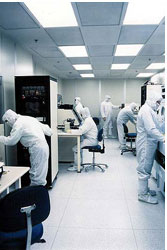
Louis Pasteur, a French chemist and one of the most influential figures in early medical microbiology, created the first vaccines for rabies and anthrax. He discovered the significance of the relationship between the world’s smallest particles, known as micro-organisms, and effects they had on people, food, and diseases. In 1854 Pasteur became professor of chemistry at the University of Lille where he worked on finding solutions to problems that plagued the manufacturing process of alcoholic drinks. He discovered that micro-organisms such as bacteria were responsible for the souring of drinks such as milk, wine, and beer. Pasteur learned that boiling water and the exclusion of air stopped meat from decomposing. He understood that controlling these organisms would enable us to cure diseases and control infection, but it was not until several years later that the same concept was carried over to an entire environment.

The first instances of cleanrooms can be traced to operating rooms within hospitals. British surgeon Joseph Lister, a pioneer of antiseptic surgery was the first to indorse the idea of sterile surgery. After studying Pasteur’s work, Lister found that using carbolic acid on wounds produced antiseptic results and in 1867, he began using it in surgery. Lister observed the positive results and started using carbolic acid to clean his surgical instruments and wash his hands. He discovered that taking these steps reduced infection and eliminated bacteria. This was the first time a conscious effort was taken to control an environment.
Lister later incorporated antiseptic sprays into his surgical practices, but this did little to control airborne contaminants. It was not until the 1960’s that Willis Whitfield created the first plans for the modern day cleanroom, a room with a controlled number of airborne particles using a filtration system.

